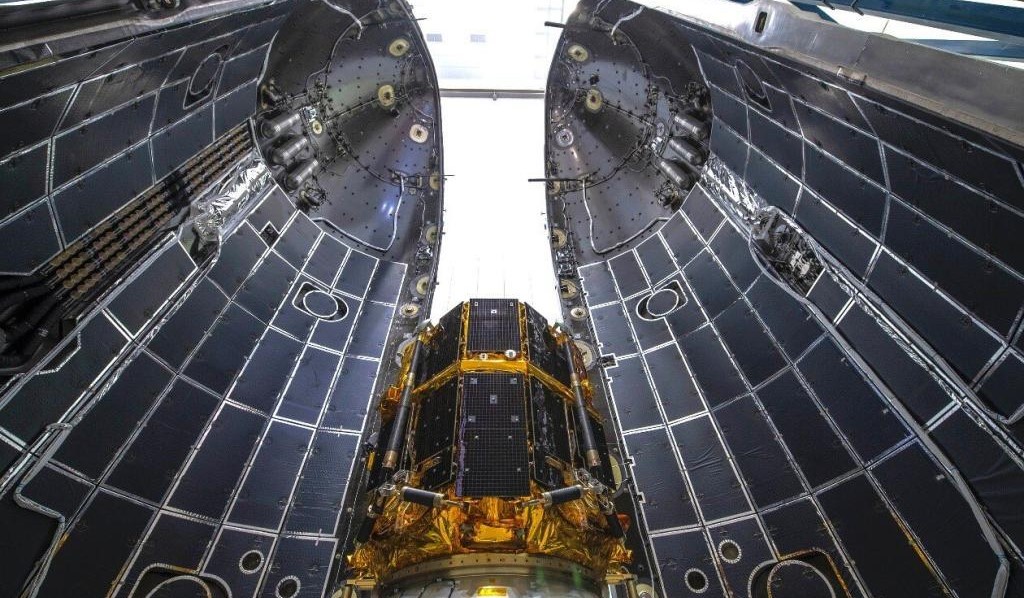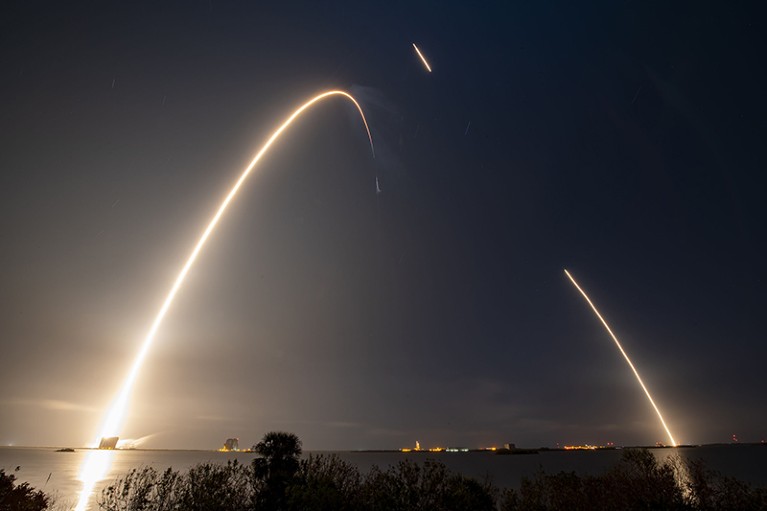Imagine a world where the history of your data is at your fingertips, clearer and more accessible...
Private Moon mission prepares for historic landing attempt
APRIL 24, 2023
The Japanese-built ispace lander, carrying a rover from the United Arab Emirates, could be the first private venture
to land on the lunar surface.

The M1 spacecraft inside SpaceX’s Falcon 9 rocket.Credit: ispace
A Japanese-made spacecraft carrying the United Arab Emirates’s (UAE) Rashid rover, will attempt to land on the Moon tomorrow. If successful, the HAKUTO-R Mission 1 (M1) will be the first commercial mission to accomplish a lunar landing, and be both countries’ first visit to the Moon’s surface.
Until now, only government-led missions from the United States, Soviet Union and China have successfully landed on the Moon. The M1 lander — made by the Tokyo-based firm ispace — is the first of several commercial lunar trips flying this year.
M1 was launched on 11 December 2022 from Cape Canaveral, Florida, in a SpaceX Falcon 9 rocket, and entered lunar orbit on 21 March. The rovers on board will study lunar soil and geology in a previously unexplored location.
“This is a new way of doing science on the Moon, a new way of doing business on the Moon as well,” says Abigail Calzada Diaz, a geologist and lunar-exploration specialist at the European Space Resources Innovation Centre in Esch-sur-Alzette, Luxembourg.
Uncharted territory
M1’s ultimate destination is Atlas crater, at the outer edge of the Moon’s Mare Frigoris (Sea of Cold). “This is a region that no previous lunar missions have explored,” says Hamid Al-Naimiy, an astrophysicist at the University of Sharjah, UAE.
The lander is scheduled to begin its landing sequence from a 100-kilometre-altitude orbit at 15:40 (UTC) on April 25. The ispace mission control team has a long checklist of procedures to complete before initiating the landing process. This includes checking the external temperature and conditions as well as the craft’s landing sensors and software, says Ryo Ujiie, chief technology officer at ispace.
To ensure a soft landing, the spacecraft will activate its navigation sensor to adjust its altitude and speed, says Ujiie. This carries an “inevitable risk”, he adds, because it will be the first and only use of the sensor in a lunar environment.
If the pre-landing checks indicate that the spacecraft cannot land safely as planned, ispace says it could make further attempts on 26 April, 1 May or 3 May.

M1 was launched on 11 December from Cape Canaveral in Florida.Credit: ispace
On landing, the craft will need to recharge its battery before deploying its two on-board rovers: the Rashid rover, built by the Mohammed bin Rashid Space Centre (MBRSC) in Dubai, UAE, and a two-wheeled robot built by the Japanese Aerospace Exploration Agency (JAXA).
A multi-camera, artificial-intelligence-enabled, 360-degree imaging system aboard the M1 spacecraft, developed by the company Canadensys Aerospace, based in Toronto, Canada, will continue to capture images and monitor the rovers after landing.
Once deployed, Rashid will drive a few hundred metres away from the lander but will remain in the Atlas crater, says Sara AlMaeeni, an engineer on Rashid’s communication system. The rover, which is about 50 centimetres long and weighs just 10 kilograms, will use its microscopic camera to study particles in the lunar soil, and use its thermal camera to scan the geological properties of the Moon’s surface.
JAXA’s baseball-sized robot will collect data on the Moon’s surface, including lunar sand known as regolith, that could help to develop autonomous-driving technology.
Soil studies
Understanding the geology of the Moon has always been an interest of lunar missions, says Calzada Diaz. “But now there is an application for that knowledge,” she adds. “We have these resources on the Moon that actually we can use to make further exploration cheaper and easier.”She says it could be possible to “extract oxygen from the rocks, you can build structures with the lunar soil, you can build parts that maybe you need to repair something”.
Data collected by UAE’s rover will also help scientists study the Solar System. “The lunar surface has a record of the early Solar System,” says Mounib El-Eid, an astrophysicist at the American University of Beirut. The Moon has no plate tectonics and has not been subject to surface erosions as Earth has, he explains.
The Rashid rover will also study lunar dust. “Those are very powdery and have sharp edges, like glass, and can affect the equipment of astronauts and their spacesuits over time,” says AlMaeeni. Finding solutions to surviving lunar dust will be a key step in establishing permanent space stations on the Moon, she adds. The rover will run material-suitability tests. “This experiment will help us in determining suitable materials for hardware in future lunar missions.”
Powering down
The M1 lander will be switched off once night falls on the Moon, 12–14 Earth days after landing. This will almost certainly mark the end of its mission: neither the M1 lander nor the Rashid rover are equipped to survive the low temperatures during lunar night. “We are expecting that the battery will not work during the second lunar day,” says AlMaeeni.
The rover will send the data it collects to the MBRSC. “It will take months or years to analyse it,” says Al-Naimiy, who is president of the Arab Union for Astronomy and Space Sciences (AUASS).
Private companies are flocking to the Moon — what does that mean for science?
El-Eid hopes that the UAE’s first lunar mission will boost research in the Middle East. The focus should not just be on “spending money to build rovers or spaceships, you have to do some research with the data”, says El-Eid, who is Lebanon’s representative at the AUASS.
ispace is already working on its second and third Moon missions, targeting launches in 2024 and 2025 respectively. For mission 2, “we are going to carry our own small rover and we can do some more scientific research”, says Ujiie.



